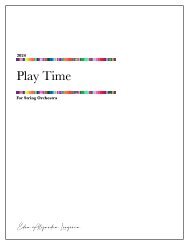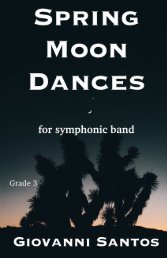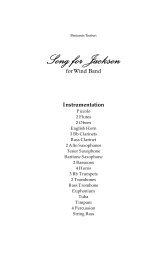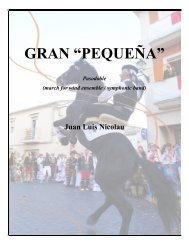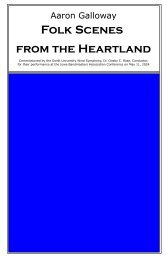You also want an ePaper? Increase the reach of your titles
YUMPU automatically turns print PDFs into web optimized ePapers that Google loves.
Performance Notes<br />
Nontraditional <strong>in</strong>struments:<br />
G S<strong>in</strong>g<strong>in</strong>g Bowls: (Also known as Prayer Bowls) are a special feature for this work mak<strong>in</strong>g it unique and<br />
true to <strong>the</strong> meditative nature of <strong>the</strong> programmatic narrative. A m<strong>in</strong>imum of two bowls are requested;<br />
however, more may be used if available. If us<strong>in</strong>g only two bowls, <strong>the</strong>y should be performed near <strong>the</strong><br />
timpanist so that he/she has easy access to <strong>the</strong>m for <strong>the</strong> end of <strong>the</strong> work. There are four ways to use <strong>the</strong><br />
s<strong>in</strong>g<strong>in</strong>g bowls. Pitches near C and A are most desirable, followed by pitches <strong>in</strong> <strong>the</strong> F major scale;<br />
however, <strong>the</strong> bowls may be unpitched. For <strong>in</strong>formation on where to buy s<strong>in</strong>g<strong>in</strong>g bowls, please visit<br />
www.jonigreene.com and select <strong>in</strong> <strong>the</strong> <strong>stillness</strong> from <strong>the</strong> “Works” page.<br />
1) Strik<strong>in</strong>g <strong>the</strong> bowl: (example Tuba, m. 22) follow dynamic <strong>in</strong>dications on how loudly to strike<br />
<strong>the</strong> side of <strong>the</strong> bowl with <strong>in</strong>strument’s provided wooden mallet. Some bowls also utilize a<br />
cushion placed under <strong>the</strong> bowl which rests <strong>in</strong> <strong>the</strong> palm of <strong>the</strong> hand. It will be necessary for<br />
players to experiment with <strong>the</strong> bowls to determ<strong>in</strong>e whe<strong>the</strong>r to use <strong>the</strong> cushion and where<br />
on <strong>the</strong> bowl to strike <strong>in</strong> order to produce <strong>the</strong> best “r<strong>in</strong>g.”<br />
2) Susta<strong>in</strong>ed sound: (example Timpani, m. 1 & Tuba m. 2) us<strong>in</strong>g provided wooden mallet (and<br />
possibly cushion), player should apply pressure to <strong>the</strong> outside rim of <strong>the</strong> bowl and move <strong>in</strong><br />
a clockwise motion. Sometimes slow and firm pressure produces a thicker and louder sound<br />
(which is preferred) ra<strong>the</strong>r than mov<strong>in</strong>g fast with less pressure aga<strong>in</strong>st <strong>the</strong> bowl. Aga<strong>in</strong>, <strong>the</strong><br />
player will need to experiment with position, pressure, and speed of <strong>the</strong> mallet aga<strong>in</strong>st <strong>the</strong><br />
bowl. If necessary, <strong>the</strong> player may also softly strike <strong>the</strong> bowl and <strong>the</strong>n beg<strong>in</strong> <strong>the</strong> circular<br />
susta<strong>in</strong> motion.<br />
3) Timpani Gliss: (example m. 91 forward) <strong>the</strong> timpanist will play one bowl throughout <strong>the</strong> work<br />
when not play<strong>in</strong>g timpani. At <strong>the</strong> end of <strong>the</strong> work at <strong>the</strong> Aleatoric W<strong>in</strong>d Chime section, <strong>the</strong><br />
timpanist has pedal glissandi which are achieved by plac<strong>in</strong>g one s<strong>in</strong>g<strong>in</strong>g bowl on drum II,<br />
and one on drum III. Us<strong>in</strong>g <strong>the</strong> s<strong>in</strong>g<strong>in</strong>g bowl mallet, <strong>the</strong> timpanist <strong>the</strong>n strikes <strong>the</strong> bowl and<br />
performs a pedal glissando rapidly. The s<strong>in</strong>g<strong>in</strong>g bowl should cont<strong>in</strong>ue to resonate<br />
throughout <strong>the</strong> glissando to achieve <strong>the</strong> requested effect.<br />
4) Arco: (example Timpani, m. 31) us<strong>in</strong>g a bass bow, player should bow <strong>the</strong> top edge of <strong>the</strong><br />
s<strong>in</strong>g<strong>in</strong>g bowl produc<strong>in</strong>g a r<strong>in</strong>g<strong>in</strong>g sound. For best results, apply pressure downward. Have<br />
<strong>the</strong> player experiment with pressure and bow placement for <strong>the</strong> best response.<br />
Below are examples of <strong>the</strong> s<strong>in</strong>g<strong>in</strong>g bowls <strong>in</strong> <strong>the</strong> timpani and tuba beg<strong>in</strong>n<strong>in</strong>g at measure 1. S<strong>in</strong>g<strong>in</strong>g bowls<br />
are always notated with an “x” through <strong>the</strong> note-head. Please note that <strong>the</strong> higher pitched bowl is<br />
notated <strong>in</strong> <strong>the</strong> timpani while <strong>the</strong> lower pitched bowl is notated <strong>in</strong> <strong>the</strong> tuba. Bowls may be distributed<br />
differently if necessary.<br />
S<strong>in</strong>g<strong>in</strong>g Bowls: example: Timpani and Tuba, measure 1. Also occurr<strong>in</strong>g at measures: 22, 31, 61, and 87.






